Foreign Policy Dilemma of China: Challenges and Solutions
VerifiedAdded on 2023/06/11
|15
|3924
|163
AI Summary
This report discusses the foreign policy dilemma of China, including challenges and solutions. It analyzes China's relationship with the United States, Japan, and Southeast Asian nations, and provides recommendations for conducting business with China.
Contribute Materials
Your contribution can guide someone’s learning journey. Share your
documents today.
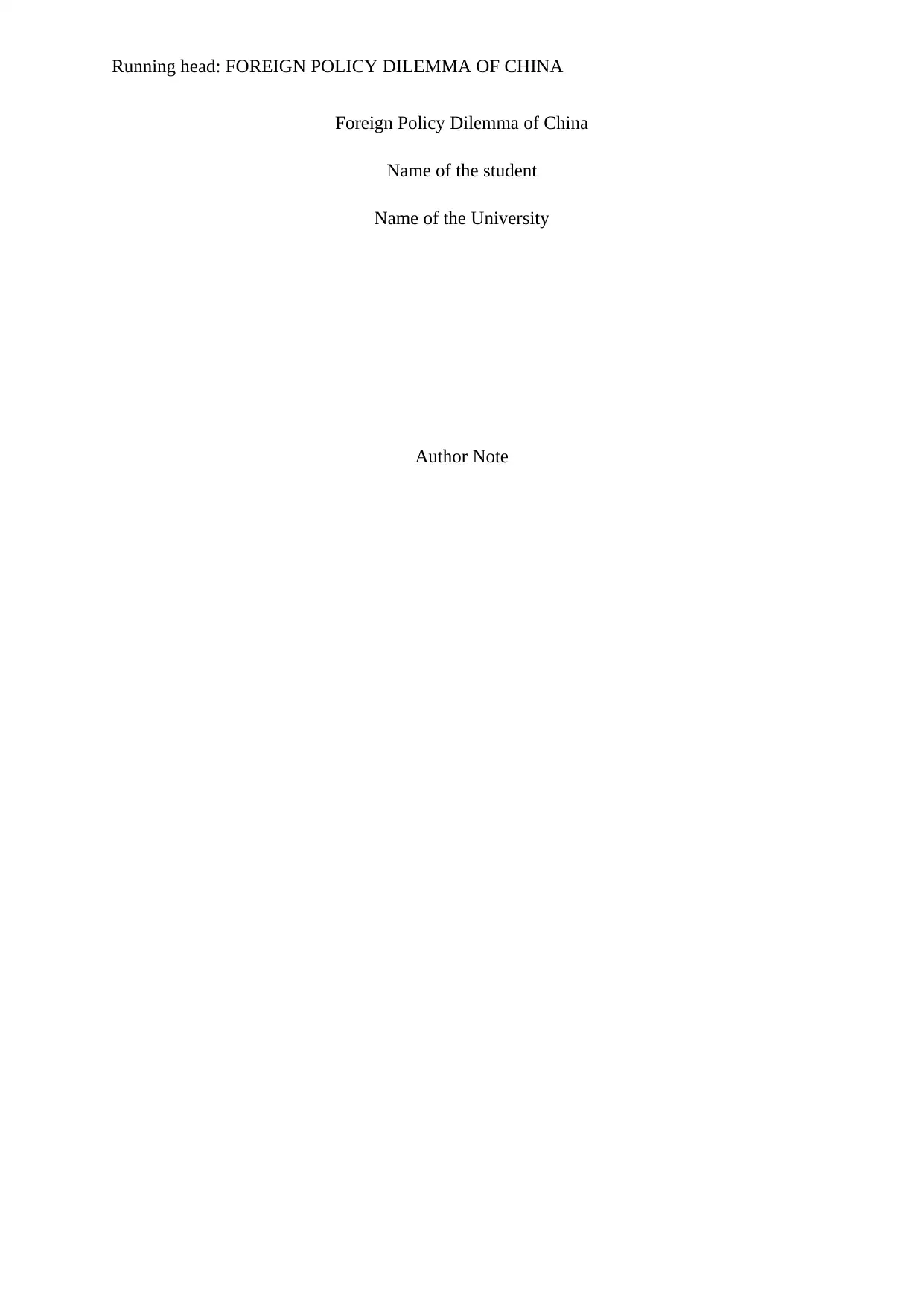
Running head: FOREIGN POLICY DILEMMA OF CHINA
Foreign Policy Dilemma of China
Name of the student
Name of the University
Author Note
Foreign Policy Dilemma of China
Name of the student
Name of the University
Author Note
Secure Best Marks with AI Grader
Need help grading? Try our AI Grader for instant feedback on your assignments.
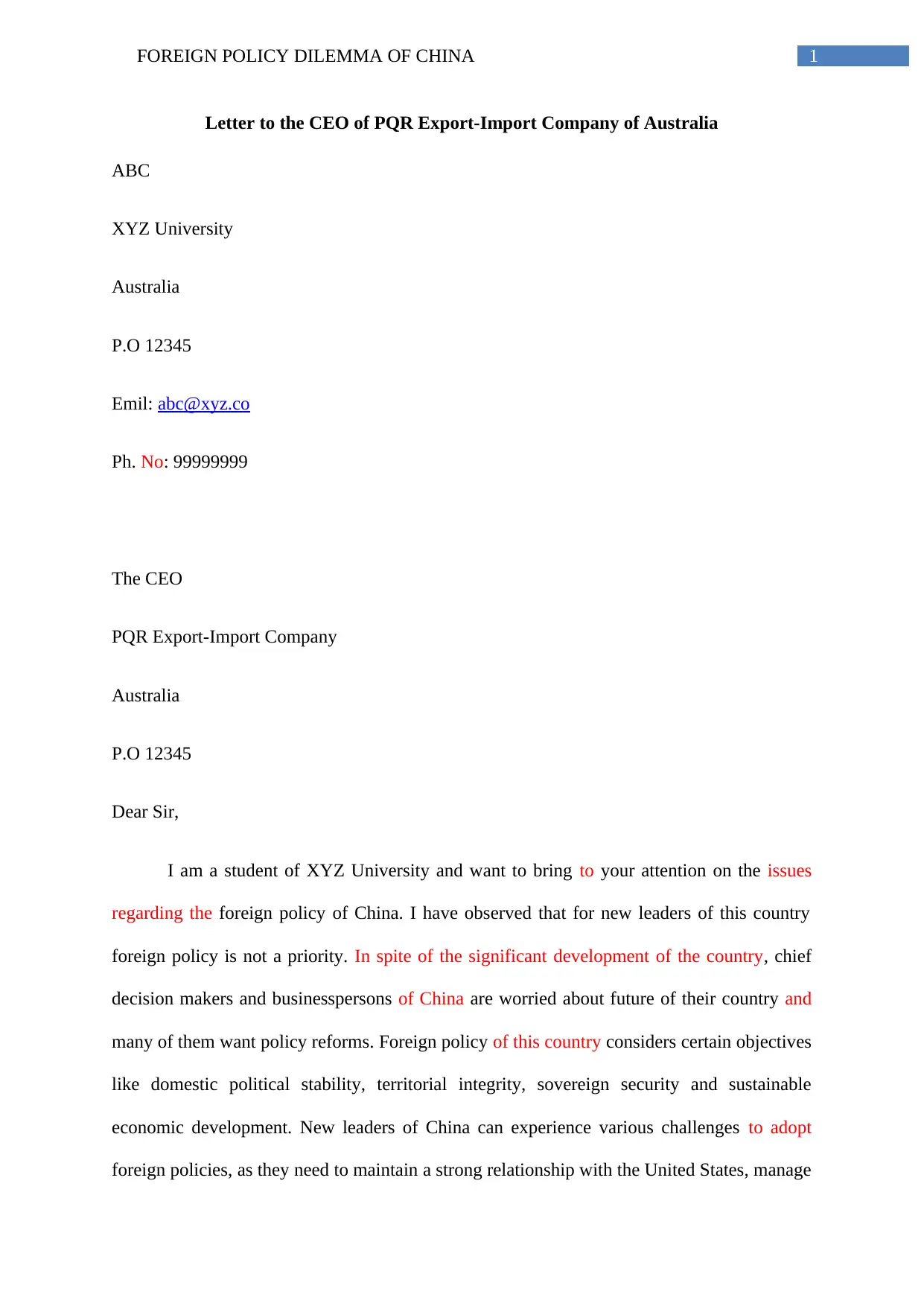
1FOREIGN POLICY DILEMMA OF CHINA
Letter to the CEO of PQR Export-Import Company of Australia
ABC
XYZ University
Australia
P.O 12345
Emil: abc@xyz.co
Ph. No: 99999999
The CEO
PQR Export-Import Company
Australia
P.O 12345
Dear Sir,
I am a student of XYZ University and want to bring to your attention on the issues
regarding the foreign policy of China. I have observed that for new leaders of this country
foreign policy is not a priority. In spite of the significant development of the country, chief
decision makers and businesspersons of China are worried about future of their country and
many of them want policy reforms. Foreign policy of this country considers certain objectives
like domestic political stability, territorial integrity, sovereign security and sustainable
economic development. New leaders of China can experience various challenges to adopt
foreign policies, as they need to maintain a strong relationship with the United States, manage
Letter to the CEO of PQR Export-Import Company of Australia
ABC
XYZ University
Australia
P.O 12345
Emil: abc@xyz.co
Ph. No: 99999999
The CEO
PQR Export-Import Company
Australia
P.O 12345
Dear Sir,
I am a student of XYZ University and want to bring to your attention on the issues
regarding the foreign policy of China. I have observed that for new leaders of this country
foreign policy is not a priority. In spite of the significant development of the country, chief
decision makers and businesspersons of China are worried about future of their country and
many of them want policy reforms. Foreign policy of this country considers certain objectives
like domestic political stability, territorial integrity, sovereign security and sustainable
economic development. New leaders of China can experience various challenges to adopt
foreign policies, as they need to maintain a strong relationship with the United States, manage
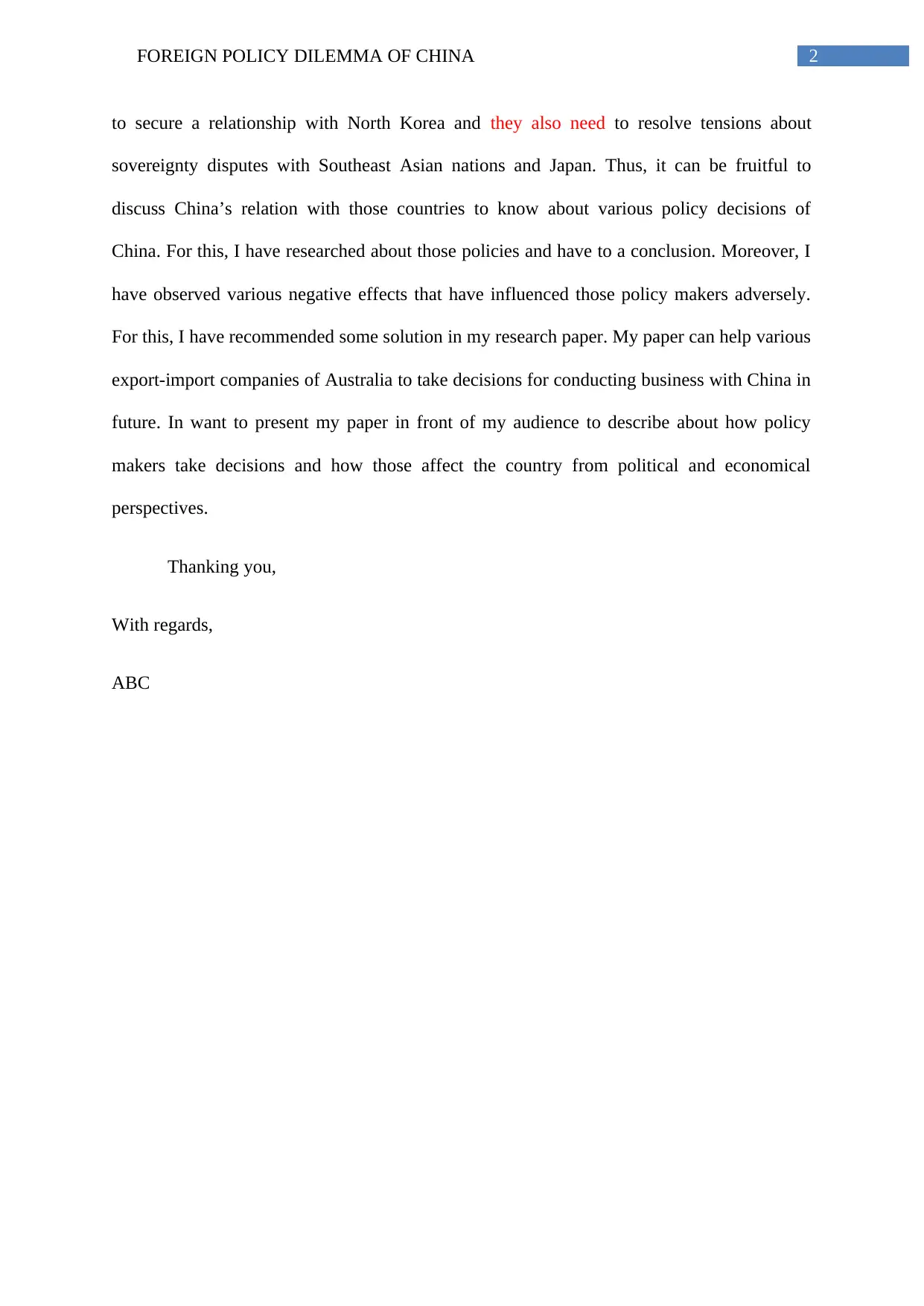
2FOREIGN POLICY DILEMMA OF CHINA
to secure a relationship with North Korea and they also need to resolve tensions about
sovereignty disputes with Southeast Asian nations and Japan. Thus, it can be fruitful to
discuss China’s relation with those countries to know about various policy decisions of
China. For this, I have researched about those policies and have to a conclusion. Moreover, I
have observed various negative effects that have influenced those policy makers adversely.
For this, I have recommended some solution in my research paper. My paper can help various
export-import companies of Australia to take decisions for conducting business with China in
future. In want to present my paper in front of my audience to describe about how policy
makers take decisions and how those affect the country from political and economical
perspectives.
Thanking you,
With regards,
ABC
to secure a relationship with North Korea and they also need to resolve tensions about
sovereignty disputes with Southeast Asian nations and Japan. Thus, it can be fruitful to
discuss China’s relation with those countries to know about various policy decisions of
China. For this, I have researched about those policies and have to a conclusion. Moreover, I
have observed various negative effects that have influenced those policy makers adversely.
For this, I have recommended some solution in my research paper. My paper can help various
export-import companies of Australia to take decisions for conducting business with China in
future. In want to present my paper in front of my audience to describe about how policy
makers take decisions and how those affect the country from political and economical
perspectives.
Thanking you,
With regards,
ABC
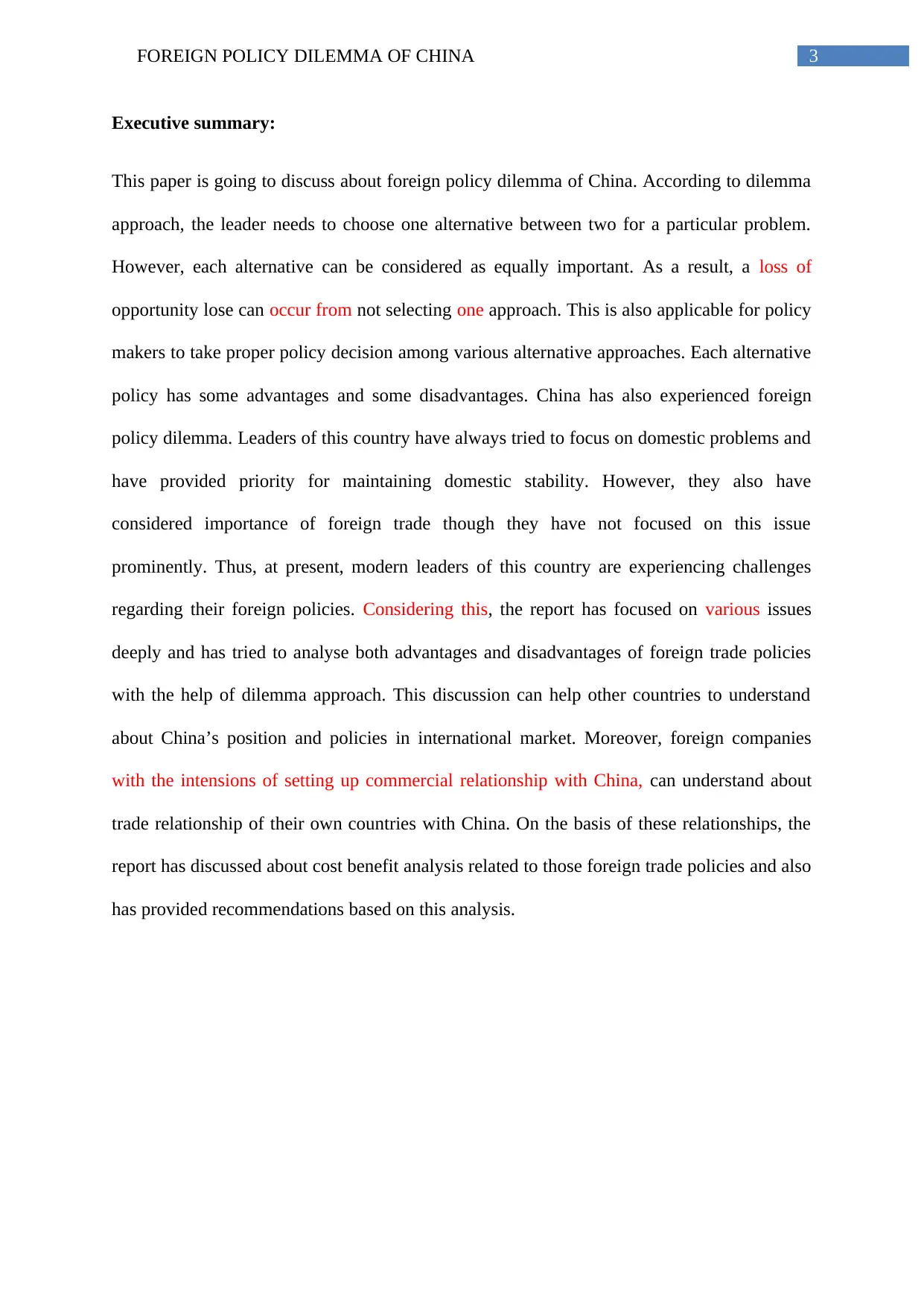
3FOREIGN POLICY DILEMMA OF CHINA
Executive summary:
This paper is going to discuss about foreign policy dilemma of China. According to dilemma
approach, the leader needs to choose one alternative between two for a particular problem.
However, each alternative can be considered as equally important. As a result, a loss of
opportunity lose can occur from not selecting one approach. This is also applicable for policy
makers to take proper policy decision among various alternative approaches. Each alternative
policy has some advantages and some disadvantages. China has also experienced foreign
policy dilemma. Leaders of this country have always tried to focus on domestic problems and
have provided priority for maintaining domestic stability. However, they also have
considered importance of foreign trade though they have not focused on this issue
prominently. Thus, at present, modern leaders of this country are experiencing challenges
regarding their foreign policies. Considering this, the report has focused on various issues
deeply and has tried to analyse both advantages and disadvantages of foreign trade policies
with the help of dilemma approach. This discussion can help other countries to understand
about China’s position and policies in international market. Moreover, foreign companies
with the intensions of setting up commercial relationship with China, can understand about
trade relationship of their own countries with China. On the basis of these relationships, the
report has discussed about cost benefit analysis related to those foreign trade policies and also
has provided recommendations based on this analysis.
Executive summary:
This paper is going to discuss about foreign policy dilemma of China. According to dilemma
approach, the leader needs to choose one alternative between two for a particular problem.
However, each alternative can be considered as equally important. As a result, a loss of
opportunity lose can occur from not selecting one approach. This is also applicable for policy
makers to take proper policy decision among various alternative approaches. Each alternative
policy has some advantages and some disadvantages. China has also experienced foreign
policy dilemma. Leaders of this country have always tried to focus on domestic problems and
have provided priority for maintaining domestic stability. However, they also have
considered importance of foreign trade though they have not focused on this issue
prominently. Thus, at present, modern leaders of this country are experiencing challenges
regarding their foreign policies. Considering this, the report has focused on various issues
deeply and has tried to analyse both advantages and disadvantages of foreign trade policies
with the help of dilemma approach. This discussion can help other countries to understand
about China’s position and policies in international market. Moreover, foreign companies
with the intensions of setting up commercial relationship with China, can understand about
trade relationship of their own countries with China. On the basis of these relationships, the
report has discussed about cost benefit analysis related to those foreign trade policies and also
has provided recommendations based on this analysis.
Secure Best Marks with AI Grader
Need help grading? Try our AI Grader for instant feedback on your assignments.
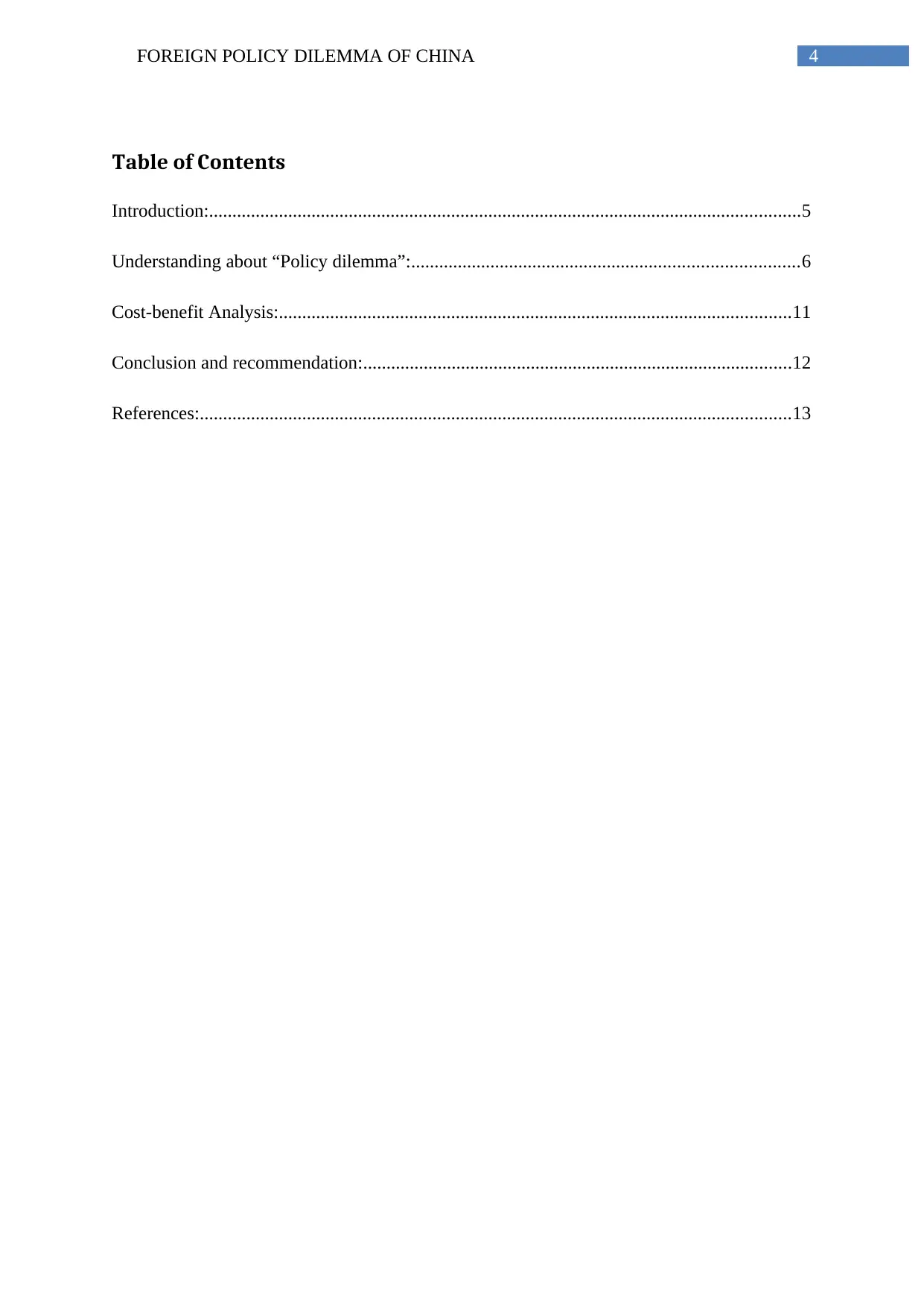
4FOREIGN POLICY DILEMMA OF CHINA
Table of Contents
Introduction:...............................................................................................................................5
Understanding about “Policy dilemma”:...................................................................................6
Cost-benefit Analysis:..............................................................................................................11
Conclusion and recommendation:............................................................................................12
References:...............................................................................................................................13
Table of Contents
Introduction:...............................................................................................................................5
Understanding about “Policy dilemma”:...................................................................................6
Cost-benefit Analysis:..............................................................................................................11
Conclusion and recommendation:............................................................................................12
References:...............................................................................................................................13
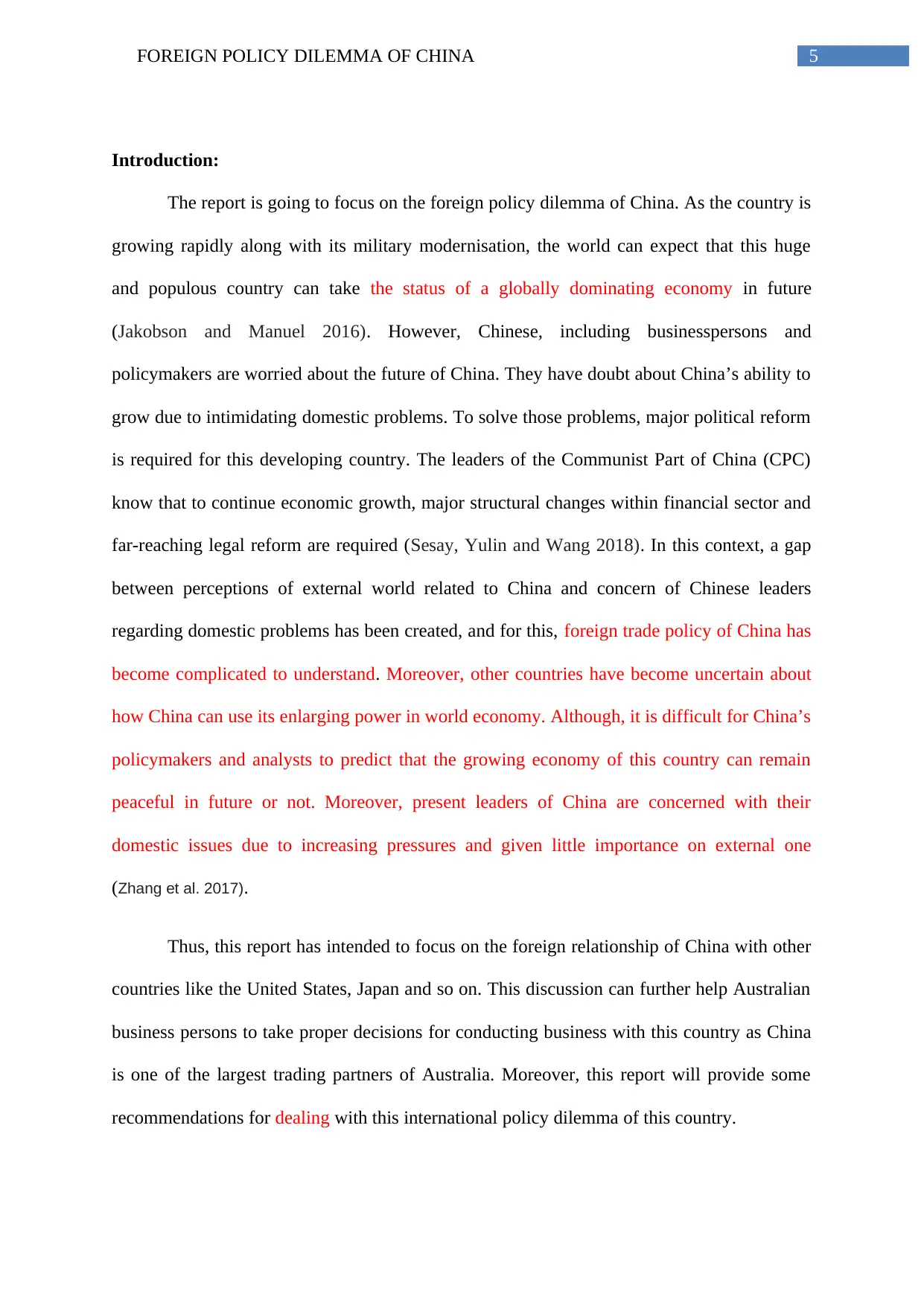
5FOREIGN POLICY DILEMMA OF CHINA
Introduction:
The report is going to focus on the foreign policy dilemma of China. As the country is
growing rapidly along with its military modernisation, the world can expect that this huge
and populous country can take the status of a globally dominating economy in future
(Jakobson and Manuel 2016). However, Chinese, including businesspersons and
policymakers are worried about the future of China. They have doubt about China’s ability to
grow due to intimidating domestic problems. To solve those problems, major political reform
is required for this developing country. The leaders of the Communist Part of China (CPC)
know that to continue economic growth, major structural changes within financial sector and
far-reaching legal reform are required (Sesay, Yulin and Wang 2018). In this context, a gap
between perceptions of external world related to China and concern of Chinese leaders
regarding domestic problems has been created, and for this, foreign trade policy of China has
become complicated to understand. Moreover, other countries have become uncertain about
how China can use its enlarging power in world economy. Although, it is difficult for China’s
policymakers and analysts to predict that the growing economy of this country can remain
peaceful in future or not. Moreover, present leaders of China are concerned with their
domestic issues due to increasing pressures and given little importance on external one
(Zhang et al. 2017).
Thus, this report has intended to focus on the foreign relationship of China with other
countries like the United States, Japan and so on. This discussion can further help Australian
business persons to take proper decisions for conducting business with this country as China
is one of the largest trading partners of Australia. Moreover, this report will provide some
recommendations for dealing with this international policy dilemma of this country.
Introduction:
The report is going to focus on the foreign policy dilemma of China. As the country is
growing rapidly along with its military modernisation, the world can expect that this huge
and populous country can take the status of a globally dominating economy in future
(Jakobson and Manuel 2016). However, Chinese, including businesspersons and
policymakers are worried about the future of China. They have doubt about China’s ability to
grow due to intimidating domestic problems. To solve those problems, major political reform
is required for this developing country. The leaders of the Communist Part of China (CPC)
know that to continue economic growth, major structural changes within financial sector and
far-reaching legal reform are required (Sesay, Yulin and Wang 2018). In this context, a gap
between perceptions of external world related to China and concern of Chinese leaders
regarding domestic problems has been created, and for this, foreign trade policy of China has
become complicated to understand. Moreover, other countries have become uncertain about
how China can use its enlarging power in world economy. Although, it is difficult for China’s
policymakers and analysts to predict that the growing economy of this country can remain
peaceful in future or not. Moreover, present leaders of China are concerned with their
domestic issues due to increasing pressures and given little importance on external one
(Zhang et al. 2017).
Thus, this report has intended to focus on the foreign relationship of China with other
countries like the United States, Japan and so on. This discussion can further help Australian
business persons to take proper decisions for conducting business with this country as China
is one of the largest trading partners of Australia. Moreover, this report will provide some
recommendations for dealing with this international policy dilemma of this country.
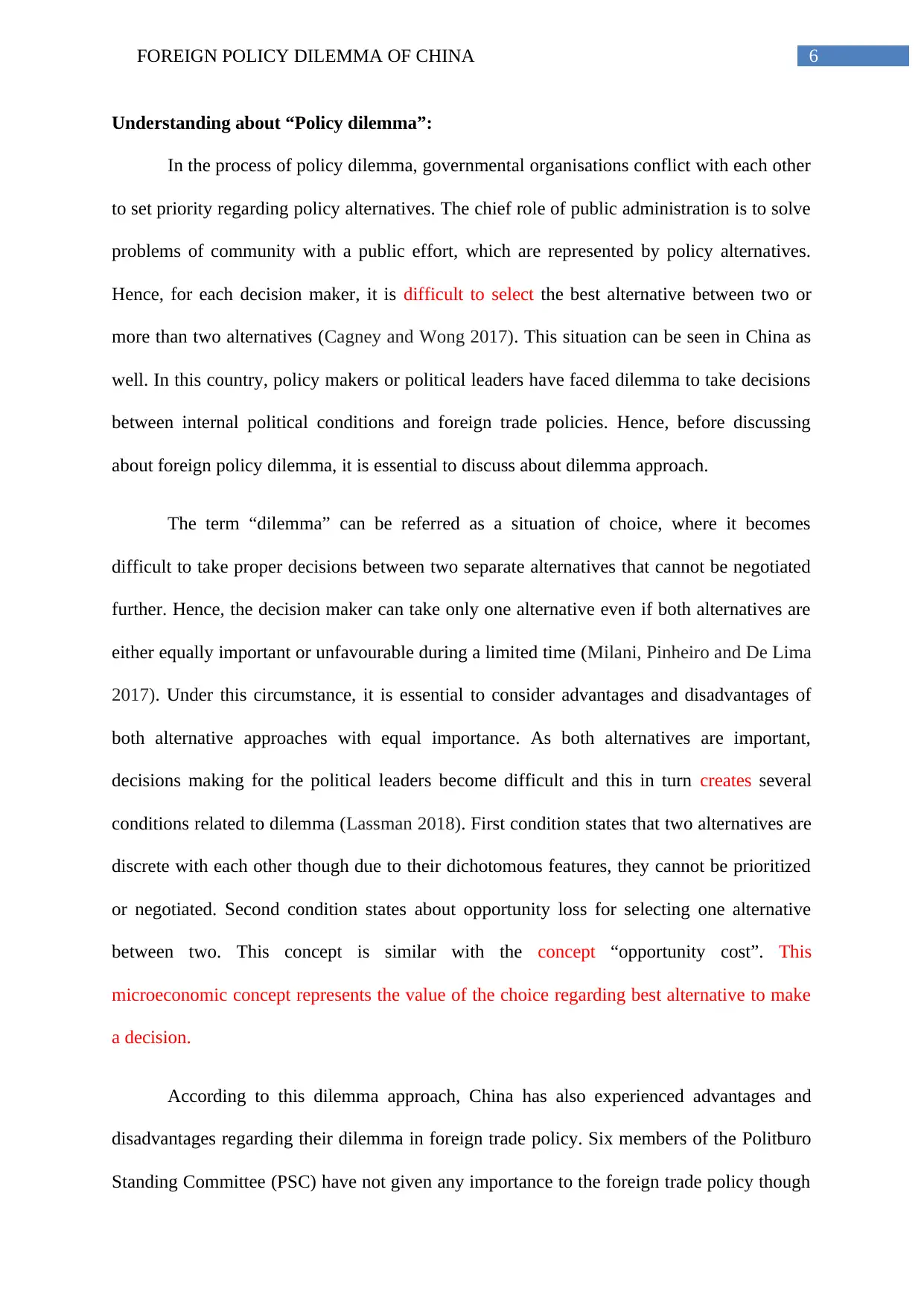
6FOREIGN POLICY DILEMMA OF CHINA
Understanding about “Policy dilemma”:
In the process of policy dilemma, governmental organisations conflict with each other
to set priority regarding policy alternatives. The chief role of public administration is to solve
problems of community with a public effort, which are represented by policy alternatives.
Hence, for each decision maker, it is difficult to select the best alternative between two or
more than two alternatives (Cagney and Wong 2017). This situation can be seen in China as
well. In this country, policy makers or political leaders have faced dilemma to take decisions
between internal political conditions and foreign trade policies. Hence, before discussing
about foreign policy dilemma, it is essential to discuss about dilemma approach.
The term “dilemma” can be referred as a situation of choice, where it becomes
difficult to take proper decisions between two separate alternatives that cannot be negotiated
further. Hence, the decision maker can take only one alternative even if both alternatives are
either equally important or unfavourable during a limited time (Milani, Pinheiro and De Lima
2017). Under this circumstance, it is essential to consider advantages and disadvantages of
both alternative approaches with equal importance. As both alternatives are important,
decisions making for the political leaders become difficult and this in turn creates several
conditions related to dilemma (Lassman 2018). First condition states that two alternatives are
discrete with each other though due to their dichotomous features, they cannot be prioritized
or negotiated. Second condition states about opportunity loss for selecting one alternative
between two. This concept is similar with the concept “opportunity cost”. This
microeconomic concept represents the value of the choice regarding best alternative to make
a decision.
According to this dilemma approach, China has also experienced advantages and
disadvantages regarding their dilemma in foreign trade policy. Six members of the Politburo
Standing Committee (PSC) have not given any importance to the foreign trade policy though
Understanding about “Policy dilemma”:
In the process of policy dilemma, governmental organisations conflict with each other
to set priority regarding policy alternatives. The chief role of public administration is to solve
problems of community with a public effort, which are represented by policy alternatives.
Hence, for each decision maker, it is difficult to select the best alternative between two or
more than two alternatives (Cagney and Wong 2017). This situation can be seen in China as
well. In this country, policy makers or political leaders have faced dilemma to take decisions
between internal political conditions and foreign trade policies. Hence, before discussing
about foreign policy dilemma, it is essential to discuss about dilemma approach.
The term “dilemma” can be referred as a situation of choice, where it becomes
difficult to take proper decisions between two separate alternatives that cannot be negotiated
further. Hence, the decision maker can take only one alternative even if both alternatives are
either equally important or unfavourable during a limited time (Milani, Pinheiro and De Lima
2017). Under this circumstance, it is essential to consider advantages and disadvantages of
both alternative approaches with equal importance. As both alternatives are important,
decisions making for the political leaders become difficult and this in turn creates several
conditions related to dilemma (Lassman 2018). First condition states that two alternatives are
discrete with each other though due to their dichotomous features, they cannot be prioritized
or negotiated. Second condition states about opportunity loss for selecting one alternative
between two. This concept is similar with the concept “opportunity cost”. This
microeconomic concept represents the value of the choice regarding best alternative to make
a decision.
According to this dilemma approach, China has also experienced advantages and
disadvantages regarding their dilemma in foreign trade policy. Six members of the Politburo
Standing Committee (PSC) have not given any importance to the foreign trade policy though
Paraphrase This Document
Need a fresh take? Get an instant paraphrase of this document with our AI Paraphraser
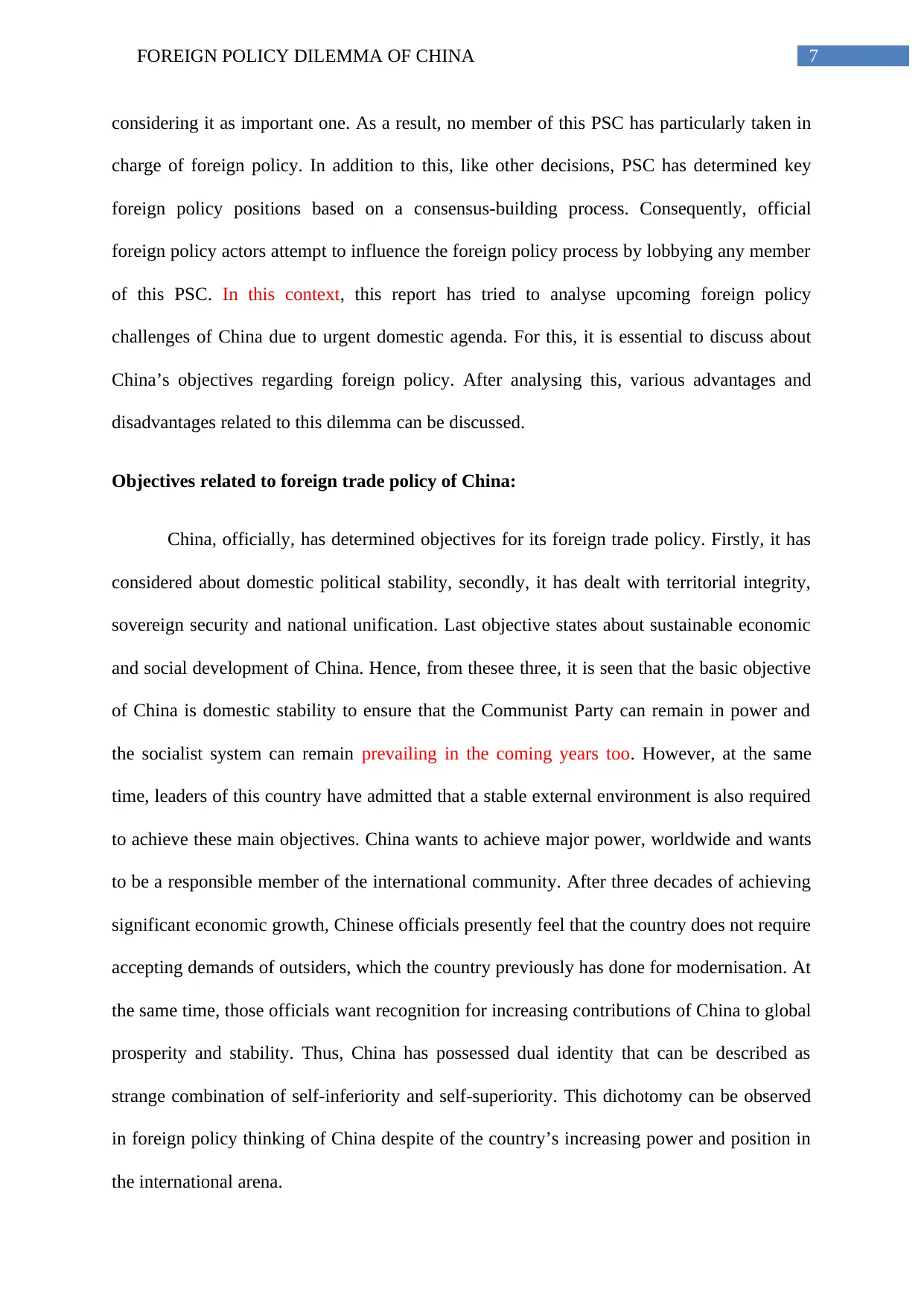
7FOREIGN POLICY DILEMMA OF CHINA
considering it as important one. As a result, no member of this PSC has particularly taken in
charge of foreign policy. In addition to this, like other decisions, PSC has determined key
foreign policy positions based on a consensus-building process. Consequently, official
foreign policy actors attempt to influence the foreign policy process by lobbying any member
of this PSC. In this context, this report has tried to analyse upcoming foreign policy
challenges of China due to urgent domestic agenda. For this, it is essential to discuss about
China’s objectives regarding foreign policy. After analysing this, various advantages and
disadvantages related to this dilemma can be discussed.
Objectives related to foreign trade policy of China:
China, officially, has determined objectives for its foreign trade policy. Firstly, it has
considered about domestic political stability, secondly, it has dealt with territorial integrity,
sovereign security and national unification. Last objective states about sustainable economic
and social development of China. Hence, from thesee three, it is seen that the basic objective
of China is domestic stability to ensure that the Communist Party can remain in power and
the socialist system can remain prevailing in the coming years too. However, at the same
time, leaders of this country have admitted that a stable external environment is also required
to achieve these main objectives. China wants to achieve major power, worldwide and wants
to be a responsible member of the international community. After three decades of achieving
significant economic growth, Chinese officials presently feel that the country does not require
accepting demands of outsiders, which the country previously has done for modernisation. At
the same time, those officials want recognition for increasing contributions of China to global
prosperity and stability. Thus, China has possessed dual identity that can be described as
strange combination of self-inferiority and self-superiority. This dichotomy can be observed
in foreign policy thinking of China despite of the country’s increasing power and position in
the international arena.
considering it as important one. As a result, no member of this PSC has particularly taken in
charge of foreign policy. In addition to this, like other decisions, PSC has determined key
foreign policy positions based on a consensus-building process. Consequently, official
foreign policy actors attempt to influence the foreign policy process by lobbying any member
of this PSC. In this context, this report has tried to analyse upcoming foreign policy
challenges of China due to urgent domestic agenda. For this, it is essential to discuss about
China’s objectives regarding foreign policy. After analysing this, various advantages and
disadvantages related to this dilemma can be discussed.
Objectives related to foreign trade policy of China:
China, officially, has determined objectives for its foreign trade policy. Firstly, it has
considered about domestic political stability, secondly, it has dealt with territorial integrity,
sovereign security and national unification. Last objective states about sustainable economic
and social development of China. Hence, from thesee three, it is seen that the basic objective
of China is domestic stability to ensure that the Communist Party can remain in power and
the socialist system can remain prevailing in the coming years too. However, at the same
time, leaders of this country have admitted that a stable external environment is also required
to achieve these main objectives. China wants to achieve major power, worldwide and wants
to be a responsible member of the international community. After three decades of achieving
significant economic growth, Chinese officials presently feel that the country does not require
accepting demands of outsiders, which the country previously has done for modernisation. At
the same time, those officials want recognition for increasing contributions of China to global
prosperity and stability. Thus, China has possessed dual identity that can be described as
strange combination of self-inferiority and self-superiority. This dichotomy can be observed
in foreign policy thinking of China despite of the country’s increasing power and position in
the international arena.
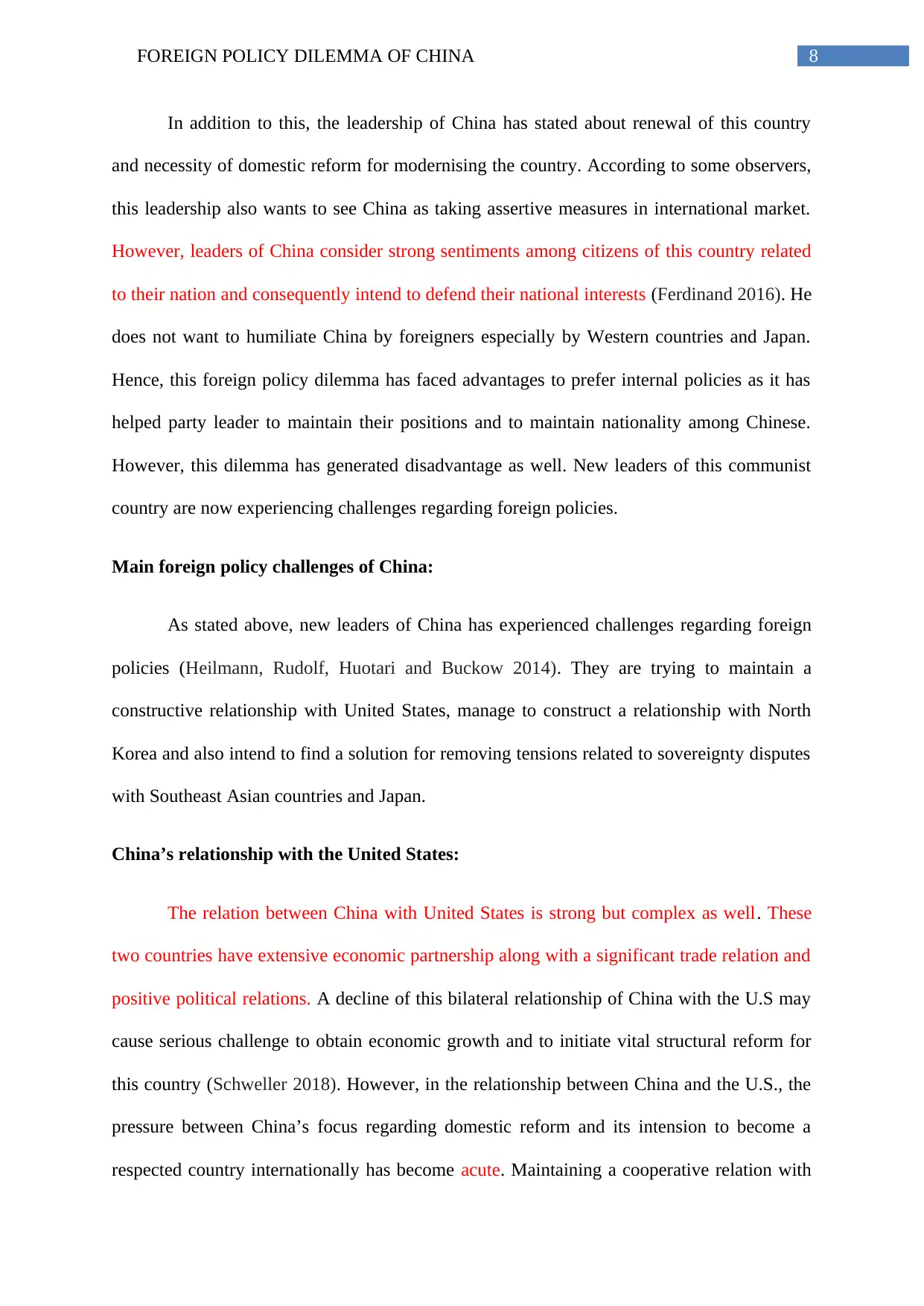
8FOREIGN POLICY DILEMMA OF CHINA
In addition to this, the leadership of China has stated about renewal of this country
and necessity of domestic reform for modernising the country. According to some observers,
this leadership also wants to see China as taking assertive measures in international market.
However, leaders of China consider strong sentiments among citizens of this country related
to their nation and consequently intend to defend their national interests (Ferdinand 2016). He
does not want to humiliate China by foreigners especially by Western countries and Japan.
Hence, this foreign policy dilemma has faced advantages to prefer internal policies as it has
helped party leader to maintain their positions and to maintain nationality among Chinese.
However, this dilemma has generated disadvantage as well. New leaders of this communist
country are now experiencing challenges regarding foreign policies.
Main foreign policy challenges of China:
As stated above, new leaders of China has experienced challenges regarding foreign
policies (Heilmann, Rudolf, Huotari and Buckow 2014). They are trying to maintain a
constructive relationship with United States, manage to construct a relationship with North
Korea and also intend to find a solution for removing tensions related to sovereignty disputes
with Southeast Asian countries and Japan.
China’s relationship with the United States:
The relation between China with United States is strong but complex as well. These
two countries have extensive economic partnership along with a significant trade relation and
positive political relations. A decline of this bilateral relationship of China with the U.S may
cause serious challenge to obtain economic growth and to initiate vital structural reform for
this country (Schweller 2018). However, in the relationship between China and the U.S., the
pressure between China’s focus regarding domestic reform and its intension to become a
respected country internationally has become acute. Maintaining a cooperative relation with
In addition to this, the leadership of China has stated about renewal of this country
and necessity of domestic reform for modernising the country. According to some observers,
this leadership also wants to see China as taking assertive measures in international market.
However, leaders of China consider strong sentiments among citizens of this country related
to their nation and consequently intend to defend their national interests (Ferdinand 2016). He
does not want to humiliate China by foreigners especially by Western countries and Japan.
Hence, this foreign policy dilemma has faced advantages to prefer internal policies as it has
helped party leader to maintain their positions and to maintain nationality among Chinese.
However, this dilemma has generated disadvantage as well. New leaders of this communist
country are now experiencing challenges regarding foreign policies.
Main foreign policy challenges of China:
As stated above, new leaders of China has experienced challenges regarding foreign
policies (Heilmann, Rudolf, Huotari and Buckow 2014). They are trying to maintain a
constructive relationship with United States, manage to construct a relationship with North
Korea and also intend to find a solution for removing tensions related to sovereignty disputes
with Southeast Asian countries and Japan.
China’s relationship with the United States:
The relation between China with United States is strong but complex as well. These
two countries have extensive economic partnership along with a significant trade relation and
positive political relations. A decline of this bilateral relationship of China with the U.S may
cause serious challenge to obtain economic growth and to initiate vital structural reform for
this country (Schweller 2018). However, in the relationship between China and the U.S., the
pressure between China’s focus regarding domestic reform and its intension to become a
respected country internationally has become acute. Maintaining a cooperative relation with
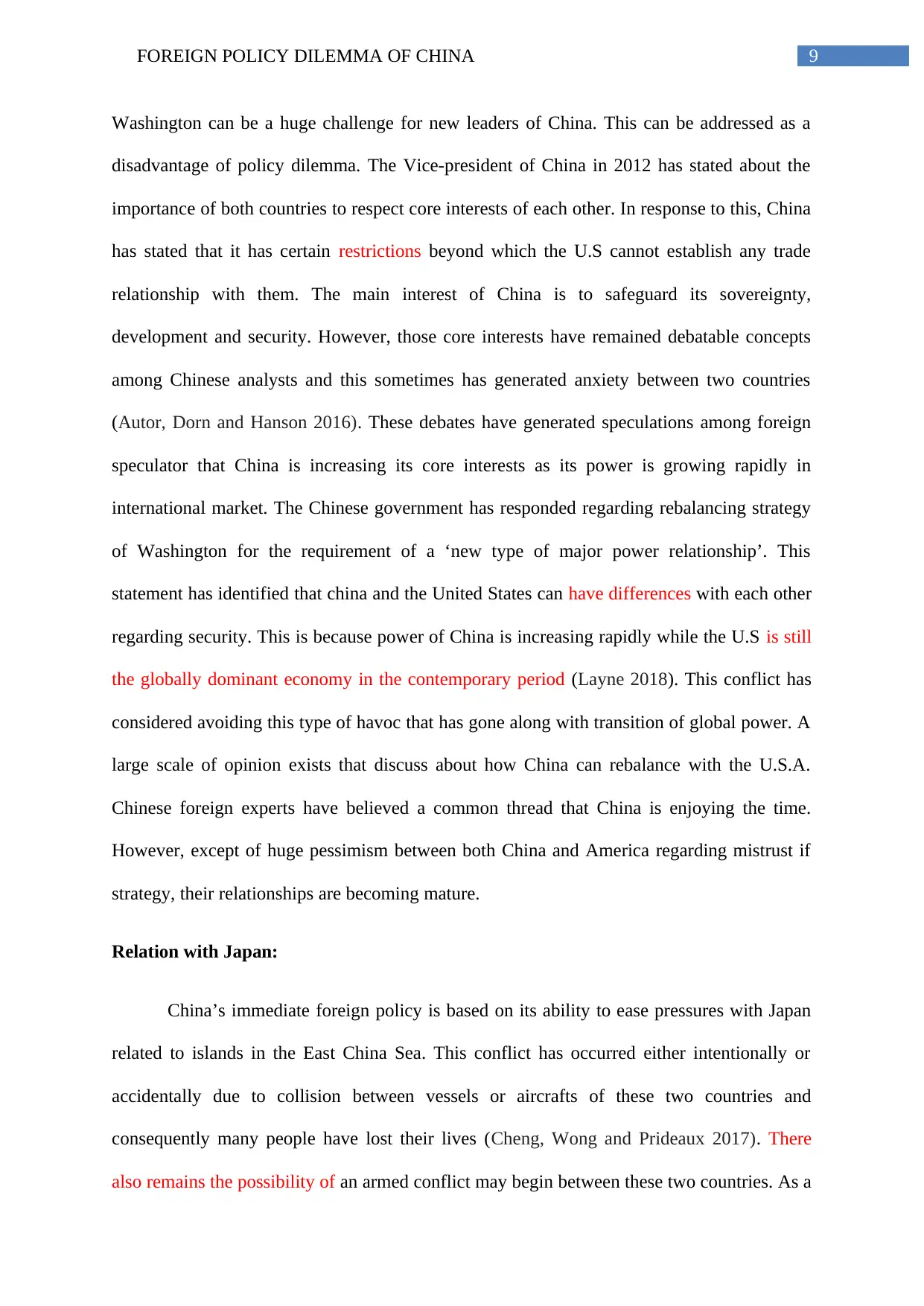
9FOREIGN POLICY DILEMMA OF CHINA
Washington can be a huge challenge for new leaders of China. This can be addressed as a
disadvantage of policy dilemma. The Vice-president of China in 2012 has stated about the
importance of both countries to respect core interests of each other. In response to this, China
has stated that it has certain restrictions beyond which the U.S cannot establish any trade
relationship with them. The main interest of China is to safeguard its sovereignty,
development and security. However, those core interests have remained debatable concepts
among Chinese analysts and this sometimes has generated anxiety between two countries
(Autor, Dorn and Hanson 2016). These debates have generated speculations among foreign
speculator that China is increasing its core interests as its power is growing rapidly in
international market. The Chinese government has responded regarding rebalancing strategy
of Washington for the requirement of a ‘new type of major power relationship’. This
statement has identified that china and the United States can have differences with each other
regarding security. This is because power of China is increasing rapidly while the U.S is still
the globally dominant economy in the contemporary period (Layne 2018). This conflict has
considered avoiding this type of havoc that has gone along with transition of global power. A
large scale of opinion exists that discuss about how China can rebalance with the U.S.A.
Chinese foreign experts have believed a common thread that China is enjoying the time.
However, except of huge pessimism between both China and America regarding mistrust if
strategy, their relationships are becoming mature.
Relation with Japan:
China’s immediate foreign policy is based on its ability to ease pressures with Japan
related to islands in the East China Sea. This conflict has occurred either intentionally or
accidentally due to collision between vessels or aircrafts of these two countries and
consequently many people have lost their lives (Cheng, Wong and Prideaux 2017). There
also remains the possibility of an armed conflict may begin between these two countries. As a
Washington can be a huge challenge for new leaders of China. This can be addressed as a
disadvantage of policy dilemma. The Vice-president of China in 2012 has stated about the
importance of both countries to respect core interests of each other. In response to this, China
has stated that it has certain restrictions beyond which the U.S cannot establish any trade
relationship with them. The main interest of China is to safeguard its sovereignty,
development and security. However, those core interests have remained debatable concepts
among Chinese analysts and this sometimes has generated anxiety between two countries
(Autor, Dorn and Hanson 2016). These debates have generated speculations among foreign
speculator that China is increasing its core interests as its power is growing rapidly in
international market. The Chinese government has responded regarding rebalancing strategy
of Washington for the requirement of a ‘new type of major power relationship’. This
statement has identified that china and the United States can have differences with each other
regarding security. This is because power of China is increasing rapidly while the U.S is still
the globally dominant economy in the contemporary period (Layne 2018). This conflict has
considered avoiding this type of havoc that has gone along with transition of global power. A
large scale of opinion exists that discuss about how China can rebalance with the U.S.A.
Chinese foreign experts have believed a common thread that China is enjoying the time.
However, except of huge pessimism between both China and America regarding mistrust if
strategy, their relationships are becoming mature.
Relation with Japan:
China’s immediate foreign policy is based on its ability to ease pressures with Japan
related to islands in the East China Sea. This conflict has occurred either intentionally or
accidentally due to collision between vessels or aircrafts of these two countries and
consequently many people have lost their lives (Cheng, Wong and Prideaux 2017). There
also remains the possibility of an armed conflict may begin between these two countries. As a
Secure Best Marks with AI Grader
Need help grading? Try our AI Grader for instant feedback on your assignments.
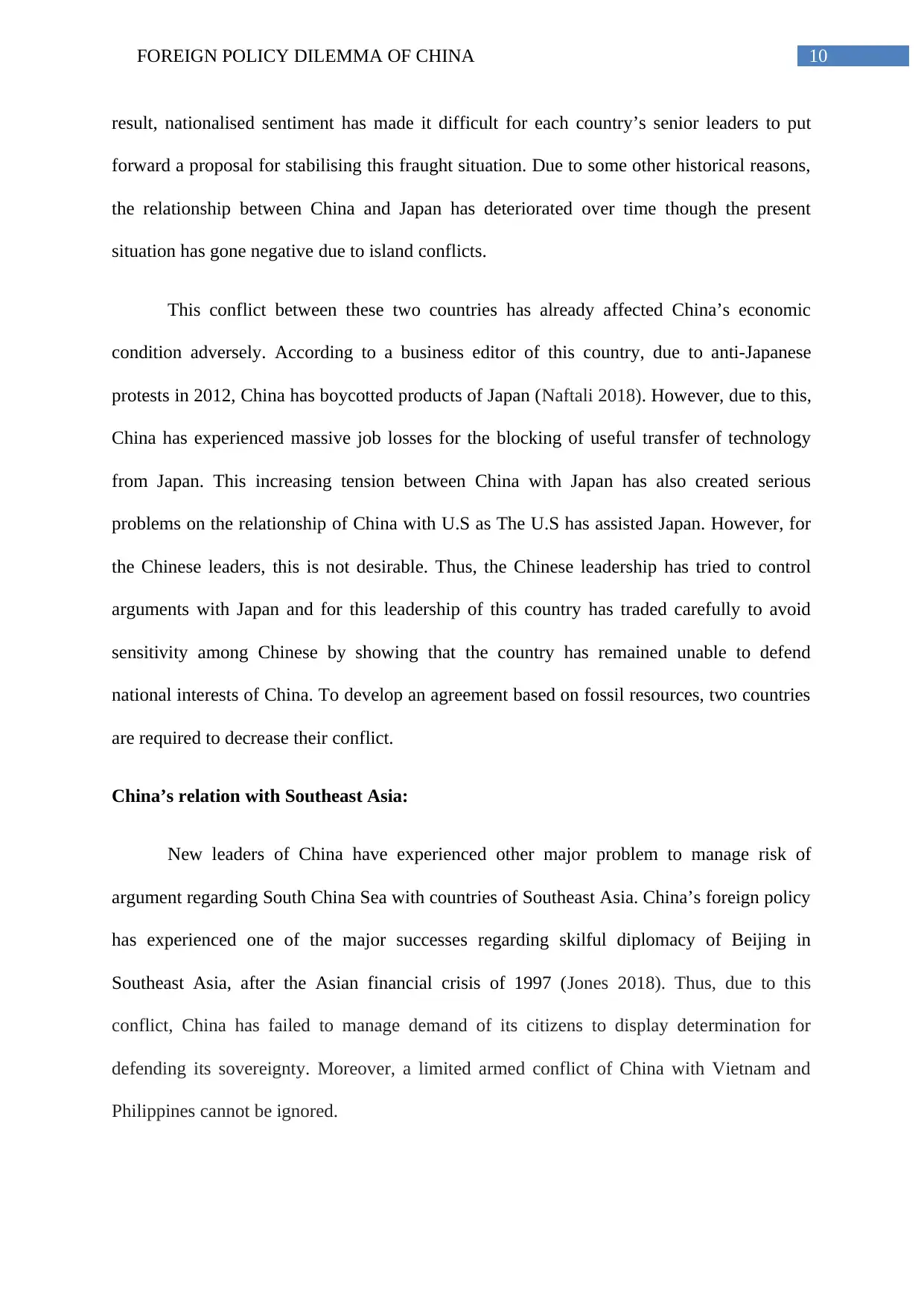
10FOREIGN POLICY DILEMMA OF CHINA
result, nationalised sentiment has made it difficult for each country’s senior leaders to put
forward a proposal for stabilising this fraught situation. Due to some other historical reasons,
the relationship between China and Japan has deteriorated over time though the present
situation has gone negative due to island conflicts.
This conflict between these two countries has already affected China’s economic
condition adversely. According to a business editor of this country, due to anti-Japanese
protests in 2012, China has boycotted products of Japan (Naftali 2018). However, due to this,
China has experienced massive job losses for the blocking of useful transfer of technology
from Japan. This increasing tension between China with Japan has also created serious
problems on the relationship of China with U.S as The U.S has assisted Japan. However, for
the Chinese leaders, this is not desirable. Thus, the Chinese leadership has tried to control
arguments with Japan and for this leadership of this country has traded carefully to avoid
sensitivity among Chinese by showing that the country has remained unable to defend
national interests of China. To develop an agreement based on fossil resources, two countries
are required to decrease their conflict.
China’s relation with Southeast Asia:
New leaders of China have experienced other major problem to manage risk of
argument regarding South China Sea with countries of Southeast Asia. China’s foreign policy
has experienced one of the major successes regarding skilful diplomacy of Beijing in
Southeast Asia, after the Asian financial crisis of 1997 (Jones 2018). Thus, due to this
conflict, China has failed to manage demand of its citizens to display determination for
defending its sovereignty. Moreover, a limited armed conflict of China with Vietnam and
Philippines cannot be ignored.
result, nationalised sentiment has made it difficult for each country’s senior leaders to put
forward a proposal for stabilising this fraught situation. Due to some other historical reasons,
the relationship between China and Japan has deteriorated over time though the present
situation has gone negative due to island conflicts.
This conflict between these two countries has already affected China’s economic
condition adversely. According to a business editor of this country, due to anti-Japanese
protests in 2012, China has boycotted products of Japan (Naftali 2018). However, due to this,
China has experienced massive job losses for the blocking of useful transfer of technology
from Japan. This increasing tension between China with Japan has also created serious
problems on the relationship of China with U.S as The U.S has assisted Japan. However, for
the Chinese leaders, this is not desirable. Thus, the Chinese leadership has tried to control
arguments with Japan and for this leadership of this country has traded carefully to avoid
sensitivity among Chinese by showing that the country has remained unable to defend
national interests of China. To develop an agreement based on fossil resources, two countries
are required to decrease their conflict.
China’s relation with Southeast Asia:
New leaders of China have experienced other major problem to manage risk of
argument regarding South China Sea with countries of Southeast Asia. China’s foreign policy
has experienced one of the major successes regarding skilful diplomacy of Beijing in
Southeast Asia, after the Asian financial crisis of 1997 (Jones 2018). Thus, due to this
conflict, China has failed to manage demand of its citizens to display determination for
defending its sovereignty. Moreover, a limited armed conflict of China with Vietnam and
Philippines cannot be ignored.
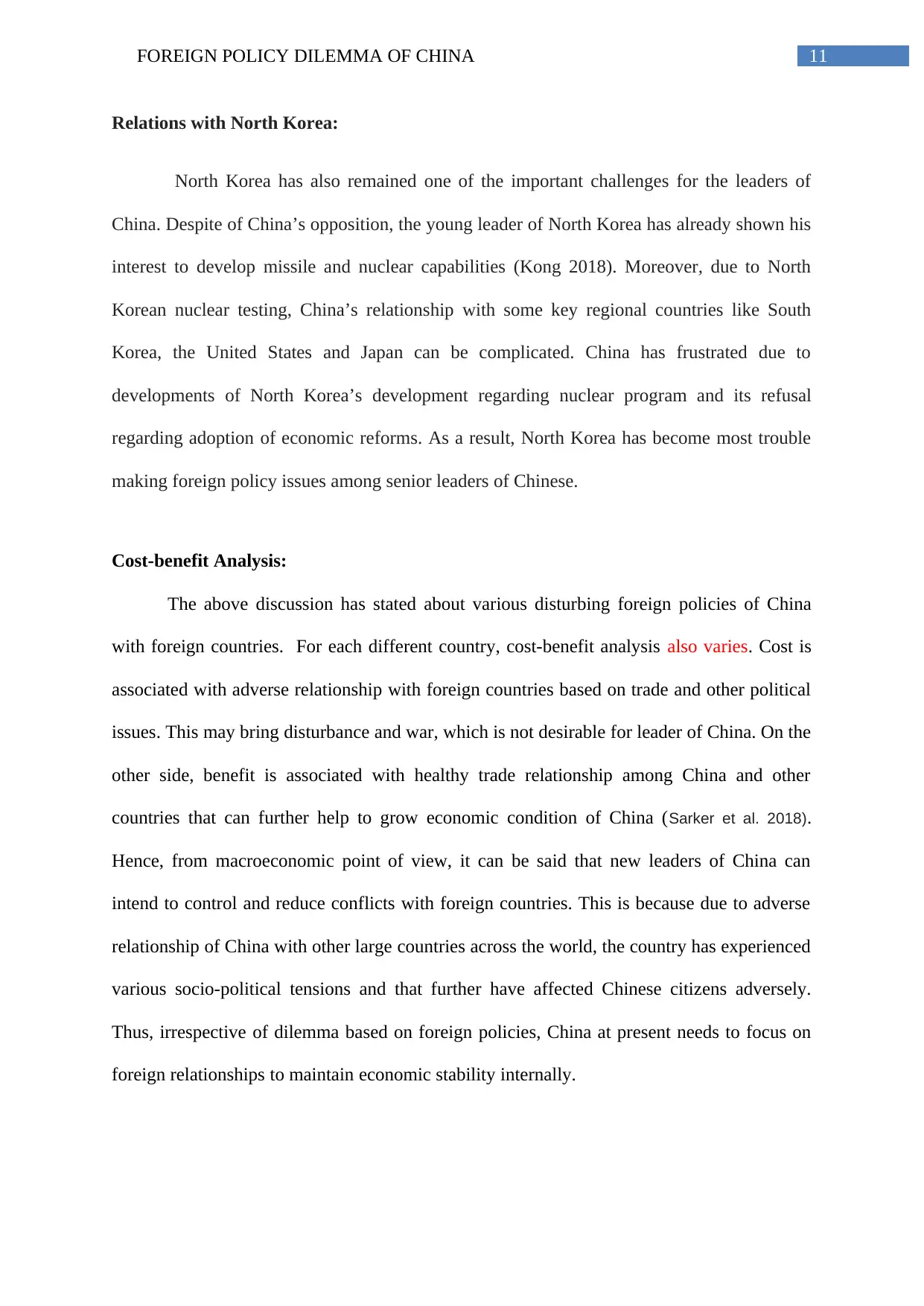
11FOREIGN POLICY DILEMMA OF CHINA
Relations with North Korea:
North Korea has also remained one of the important challenges for the leaders of
China. Despite of China’s opposition, the young leader of North Korea has already shown his
interest to develop missile and nuclear capabilities (Kong 2018). Moreover, due to North
Korean nuclear testing, China’s relationship with some key regional countries like South
Korea, the United States and Japan can be complicated. China has frustrated due to
developments of North Korea’s development regarding nuclear program and its refusal
regarding adoption of economic reforms. As a result, North Korea has become most trouble
making foreign policy issues among senior leaders of Chinese.
Cost-benefit Analysis:
The above discussion has stated about various disturbing foreign policies of China
with foreign countries. For each different country, cost-benefit analysis also varies. Cost is
associated with adverse relationship with foreign countries based on trade and other political
issues. This may bring disturbance and war, which is not desirable for leader of China. On the
other side, benefit is associated with healthy trade relationship among China and other
countries that can further help to grow economic condition of China (Sarker et al. 2018).
Hence, from macroeconomic point of view, it can be said that new leaders of China can
intend to control and reduce conflicts with foreign countries. This is because due to adverse
relationship of China with other large countries across the world, the country has experienced
various socio-political tensions and that further have affected Chinese citizens adversely.
Thus, irrespective of dilemma based on foreign policies, China at present needs to focus on
foreign relationships to maintain economic stability internally.
Relations with North Korea:
North Korea has also remained one of the important challenges for the leaders of
China. Despite of China’s opposition, the young leader of North Korea has already shown his
interest to develop missile and nuclear capabilities (Kong 2018). Moreover, due to North
Korean nuclear testing, China’s relationship with some key regional countries like South
Korea, the United States and Japan can be complicated. China has frustrated due to
developments of North Korea’s development regarding nuclear program and its refusal
regarding adoption of economic reforms. As a result, North Korea has become most trouble
making foreign policy issues among senior leaders of Chinese.
Cost-benefit Analysis:
The above discussion has stated about various disturbing foreign policies of China
with foreign countries. For each different country, cost-benefit analysis also varies. Cost is
associated with adverse relationship with foreign countries based on trade and other political
issues. This may bring disturbance and war, which is not desirable for leader of China. On the
other side, benefit is associated with healthy trade relationship among China and other
countries that can further help to grow economic condition of China (Sarker et al. 2018).
Hence, from macroeconomic point of view, it can be said that new leaders of China can
intend to control and reduce conflicts with foreign countries. This is because due to adverse
relationship of China with other large countries across the world, the country has experienced
various socio-political tensions and that further have affected Chinese citizens adversely.
Thus, irrespective of dilemma based on foreign policies, China at present needs to focus on
foreign relationships to maintain economic stability internally.
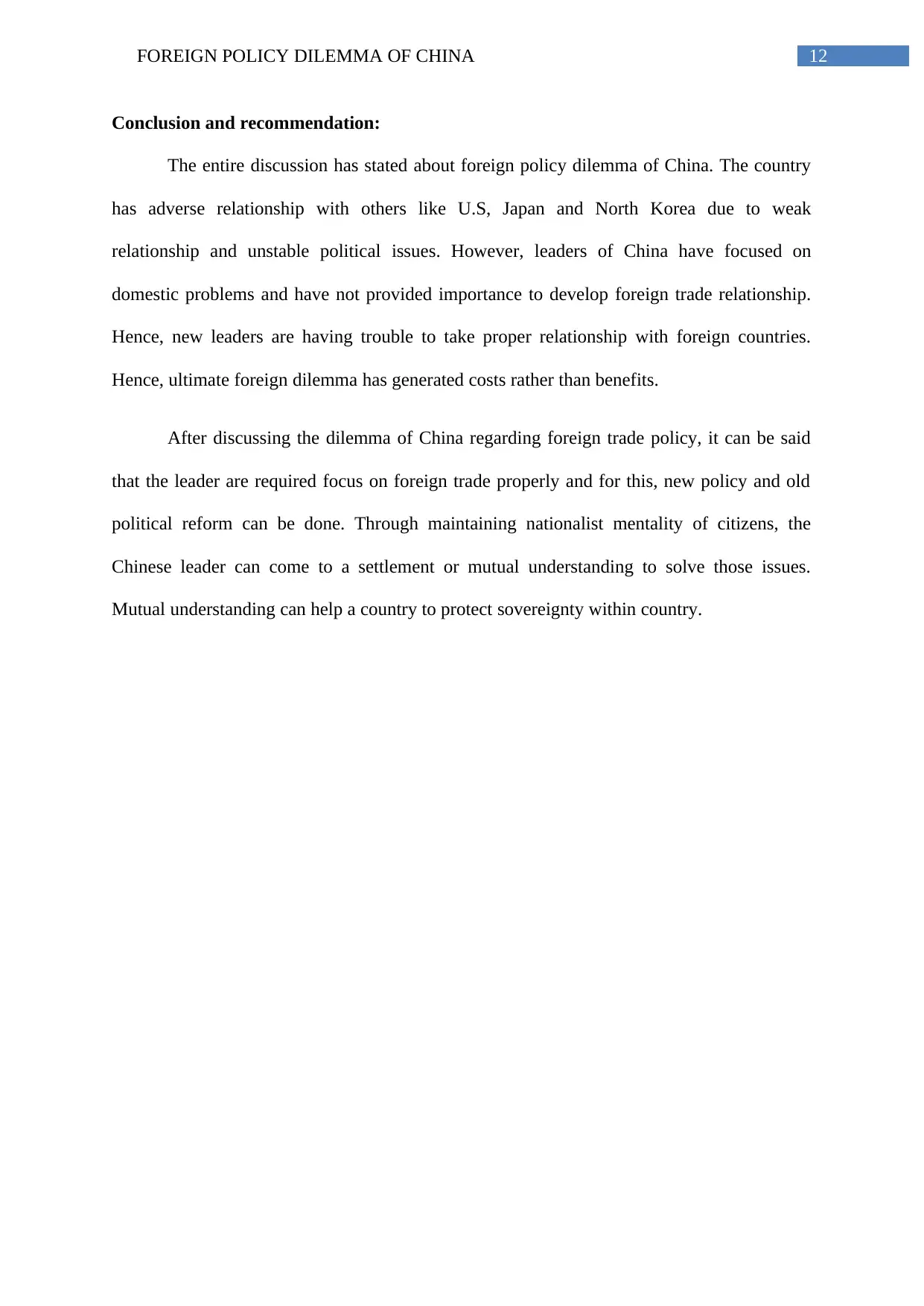
12FOREIGN POLICY DILEMMA OF CHINA
Conclusion and recommendation:
The entire discussion has stated about foreign policy dilemma of China. The country
has adverse relationship with others like U.S, Japan and North Korea due to weak
relationship and unstable political issues. However, leaders of China have focused on
domestic problems and have not provided importance to develop foreign trade relationship.
Hence, new leaders are having trouble to take proper relationship with foreign countries.
Hence, ultimate foreign dilemma has generated costs rather than benefits.
After discussing the dilemma of China regarding foreign trade policy, it can be said
that the leader are required focus on foreign trade properly and for this, new policy and old
political reform can be done. Through maintaining nationalist mentality of citizens, the
Chinese leader can come to a settlement or mutual understanding to solve those issues.
Mutual understanding can help a country to protect sovereignty within country.
Conclusion and recommendation:
The entire discussion has stated about foreign policy dilemma of China. The country
has adverse relationship with others like U.S, Japan and North Korea due to weak
relationship and unstable political issues. However, leaders of China have focused on
domestic problems and have not provided importance to develop foreign trade relationship.
Hence, new leaders are having trouble to take proper relationship with foreign countries.
Hence, ultimate foreign dilemma has generated costs rather than benefits.
After discussing the dilemma of China regarding foreign trade policy, it can be said
that the leader are required focus on foreign trade properly and for this, new policy and old
political reform can be done. Through maintaining nationalist mentality of citizens, the
Chinese leader can come to a settlement or mutual understanding to solve those issues.
Mutual understanding can help a country to protect sovereignty within country.
Paraphrase This Document
Need a fresh take? Get an instant paraphrase of this document with our AI Paraphraser
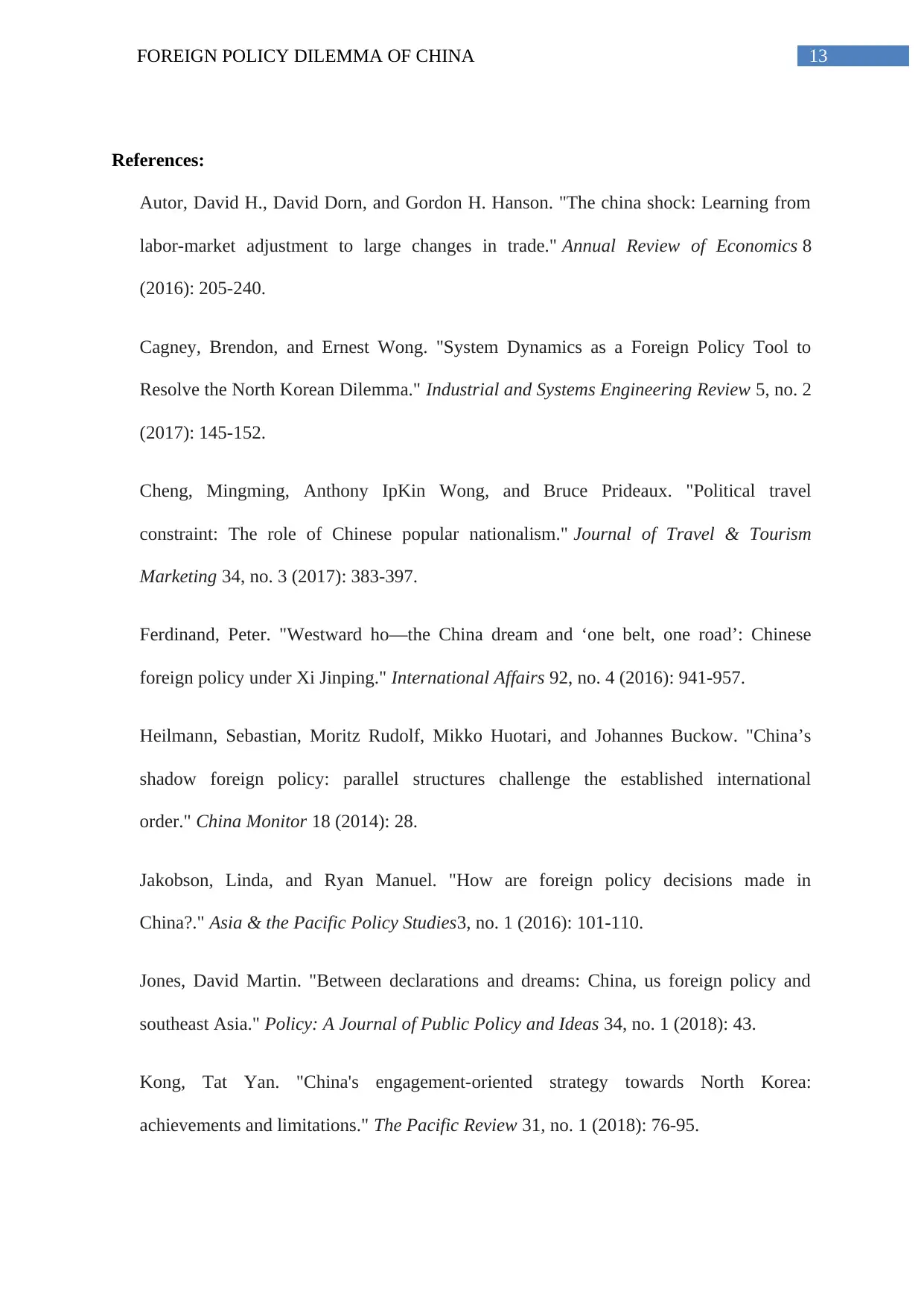
13FOREIGN POLICY DILEMMA OF CHINA
References:
Autor, David H., David Dorn, and Gordon H. Hanson. "The china shock: Learning from
labor-market adjustment to large changes in trade." Annual Review of Economics 8
(2016): 205-240.
Cagney, Brendon, and Ernest Wong. "System Dynamics as a Foreign Policy Tool to
Resolve the North Korean Dilemma." Industrial and Systems Engineering Review 5, no. 2
(2017): 145-152.
Cheng, Mingming, Anthony IpKin Wong, and Bruce Prideaux. "Political travel
constraint: The role of Chinese popular nationalism." Journal of Travel & Tourism
Marketing 34, no. 3 (2017): 383-397.
Ferdinand, Peter. "Westward ho—the China dream and ‘one belt, one road’: Chinese
foreign policy under Xi Jinping." International Affairs 92, no. 4 (2016): 941-957.
Heilmann, Sebastian, Moritz Rudolf, Mikko Huotari, and Johannes Buckow. "China’s
shadow foreign policy: parallel structures challenge the established international
order." China Monitor 18 (2014): 28.
Jakobson, Linda, and Ryan Manuel. "How are foreign policy decisions made in
China?." Asia & the Pacific Policy Studies3, no. 1 (2016): 101-110.
Jones, David Martin. "Between declarations and dreams: China, us foreign policy and
southeast Asia." Policy: A Journal of Public Policy and Ideas 34, no. 1 (2018): 43.
Kong, Tat Yan. "China's engagement-oriented strategy towards North Korea:
achievements and limitations." The Pacific Review 31, no. 1 (2018): 76-95.
References:
Autor, David H., David Dorn, and Gordon H. Hanson. "The china shock: Learning from
labor-market adjustment to large changes in trade." Annual Review of Economics 8
(2016): 205-240.
Cagney, Brendon, and Ernest Wong. "System Dynamics as a Foreign Policy Tool to
Resolve the North Korean Dilemma." Industrial and Systems Engineering Review 5, no. 2
(2017): 145-152.
Cheng, Mingming, Anthony IpKin Wong, and Bruce Prideaux. "Political travel
constraint: The role of Chinese popular nationalism." Journal of Travel & Tourism
Marketing 34, no. 3 (2017): 383-397.
Ferdinand, Peter. "Westward ho—the China dream and ‘one belt, one road’: Chinese
foreign policy under Xi Jinping." International Affairs 92, no. 4 (2016): 941-957.
Heilmann, Sebastian, Moritz Rudolf, Mikko Huotari, and Johannes Buckow. "China’s
shadow foreign policy: parallel structures challenge the established international
order." China Monitor 18 (2014): 28.
Jakobson, Linda, and Ryan Manuel. "How are foreign policy decisions made in
China?." Asia & the Pacific Policy Studies3, no. 1 (2016): 101-110.
Jones, David Martin. "Between declarations and dreams: China, us foreign policy and
southeast Asia." Policy: A Journal of Public Policy and Ideas 34, no. 1 (2018): 43.
Kong, Tat Yan. "China's engagement-oriented strategy towards North Korea:
achievements and limitations." The Pacific Review 31, no. 1 (2018): 76-95.
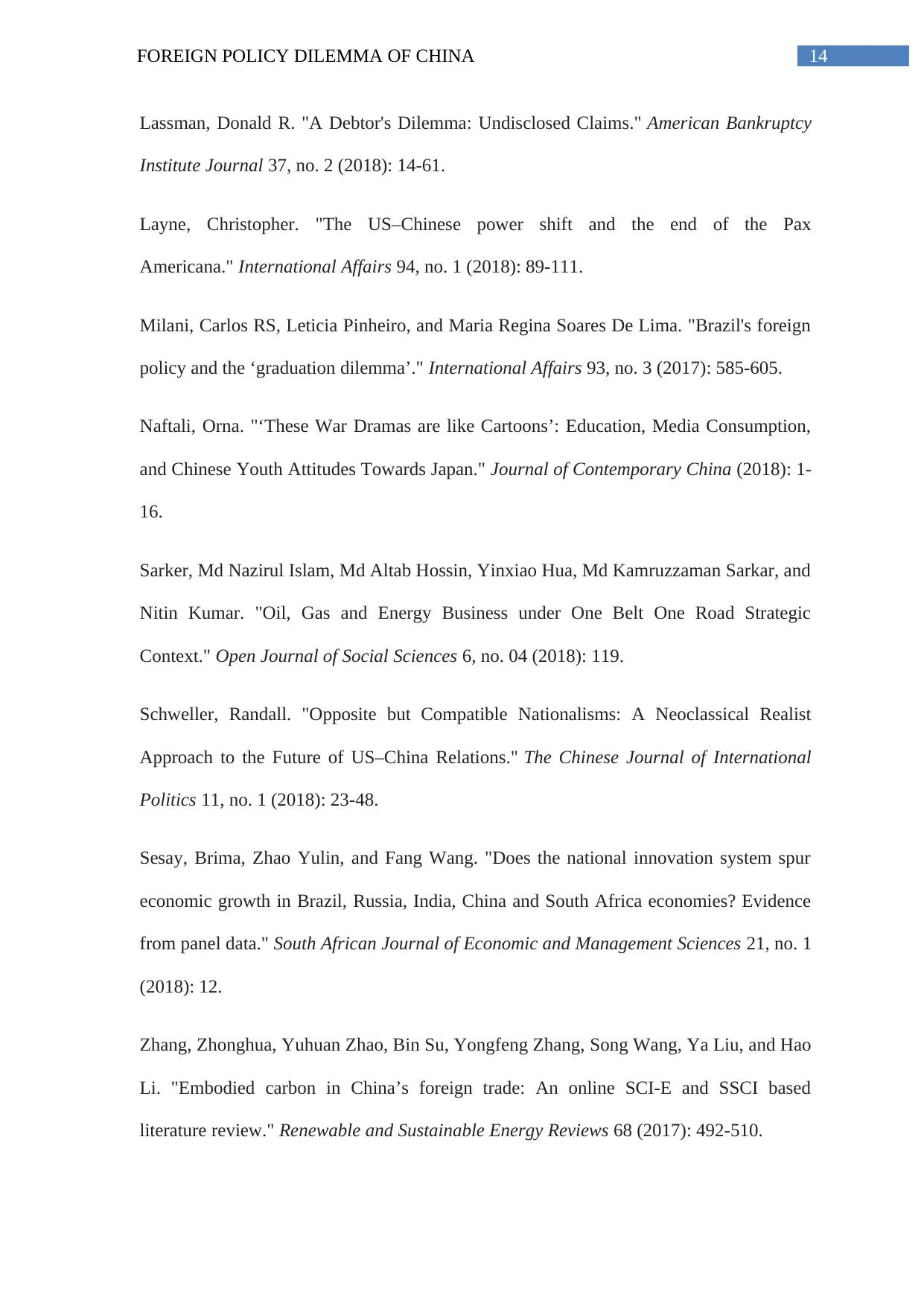
14FOREIGN POLICY DILEMMA OF CHINA
Lassman, Donald R. "A Debtor's Dilemma: Undisclosed Claims." American Bankruptcy
Institute Journal 37, no. 2 (2018): 14-61.
Layne, Christopher. "The US–Chinese power shift and the end of the Pax
Americana." International Affairs 94, no. 1 (2018): 89-111.
Milani, Carlos RS, Leticia Pinheiro, and Maria Regina Soares De Lima. "Brazil's foreign
policy and the ‘graduation dilemma’." International Affairs 93, no. 3 (2017): 585-605.
Naftali, Orna. "‘These War Dramas are like Cartoons’: Education, Media Consumption,
and Chinese Youth Attitudes Towards Japan." Journal of Contemporary China (2018): 1-
16.
Sarker, Md Nazirul Islam, Md Altab Hossin, Yinxiao Hua, Md Kamruzzaman Sarkar, and
Nitin Kumar. "Oil, Gas and Energy Business under One Belt One Road Strategic
Context." Open Journal of Social Sciences 6, no. 04 (2018): 119.
Schweller, Randall. "Opposite but Compatible Nationalisms: A Neoclassical Realist
Approach to the Future of US–China Relations." The Chinese Journal of International
Politics 11, no. 1 (2018): 23-48.
Sesay, Brima, Zhao Yulin, and Fang Wang. "Does the national innovation system spur
economic growth in Brazil, Russia, India, China and South Africa economies? Evidence
from panel data." South African Journal of Economic and Management Sciences 21, no. 1
(2018): 12.
Zhang, Zhonghua, Yuhuan Zhao, Bin Su, Yongfeng Zhang, Song Wang, Ya Liu, and Hao
Li. "Embodied carbon in China’s foreign trade: An online SCI-E and SSCI based
literature review." Renewable and Sustainable Energy Reviews 68 (2017): 492-510.
Lassman, Donald R. "A Debtor's Dilemma: Undisclosed Claims." American Bankruptcy
Institute Journal 37, no. 2 (2018): 14-61.
Layne, Christopher. "The US–Chinese power shift and the end of the Pax
Americana." International Affairs 94, no. 1 (2018): 89-111.
Milani, Carlos RS, Leticia Pinheiro, and Maria Regina Soares De Lima. "Brazil's foreign
policy and the ‘graduation dilemma’." International Affairs 93, no. 3 (2017): 585-605.
Naftali, Orna. "‘These War Dramas are like Cartoons’: Education, Media Consumption,
and Chinese Youth Attitudes Towards Japan." Journal of Contemporary China (2018): 1-
16.
Sarker, Md Nazirul Islam, Md Altab Hossin, Yinxiao Hua, Md Kamruzzaman Sarkar, and
Nitin Kumar. "Oil, Gas and Energy Business under One Belt One Road Strategic
Context." Open Journal of Social Sciences 6, no. 04 (2018): 119.
Schweller, Randall. "Opposite but Compatible Nationalisms: A Neoclassical Realist
Approach to the Future of US–China Relations." The Chinese Journal of International
Politics 11, no. 1 (2018): 23-48.
Sesay, Brima, Zhao Yulin, and Fang Wang. "Does the national innovation system spur
economic growth in Brazil, Russia, India, China and South Africa economies? Evidence
from panel data." South African Journal of Economic and Management Sciences 21, no. 1
(2018): 12.
Zhang, Zhonghua, Yuhuan Zhao, Bin Su, Yongfeng Zhang, Song Wang, Ya Liu, and Hao
Li. "Embodied carbon in China’s foreign trade: An online SCI-E and SSCI based
literature review." Renewable and Sustainable Energy Reviews 68 (2017): 492-510.
1 out of 15
Your All-in-One AI-Powered Toolkit for Academic Success.
+13062052269
info@desklib.com
Available 24*7 on WhatsApp / Email
![[object Object]](/_next/static/media/star-bottom.7253800d.svg)
Unlock your academic potential
© 2024 | Zucol Services PVT LTD | All rights reserved.
